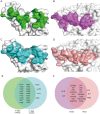Receptor binding and structural basis of raccoon dog ACE2 binding to SARS-CoV-2 prototype and its variants
- PMID: 39637248
- PMCID: PMC11620640
- DOI: 10.1371/journal.ppat.1012713
Receptor binding and structural basis of raccoon dog ACE2 binding to SARS-CoV-2 prototype and its variants
Abstract
Raccoon dog was proposed as a potential host of SARS-CoV-2, but no evidence support such a notion. In our study, we investigated the binding affinities of raccoon dog ACE2 (rdACE2) to the spike (S) protein receptor binding domain (RBD) of SARS-CoV-2 prototype (PT) and its variants. It revealed that the binding affinities of RBD from SARS-CoV-2 variants were generally lower than that of the PT RBD. Through structural and functional analyses, we found amino acids H34 and M82 play pivotal roles in maintaining the binding affinity of ACE2 to different SARS-CoV-2 sub-variants. These results suggest that raccoon dogs exhibit lower susceptibility to SARS-CoV-2 compared to those animal species with a high prevalence of SARS-CoV-2 transmission.
Copyright: © 2024 Luo et al. This is an open access article distributed under the terms of the Creative Commons Attribution License, which permits unrestricted use, distribution, and reproduction in any medium, provided the original author and source are credited.
Conflict of interest statement
The authors have declared that no competing interests exist.
Figures





Similar articles
-
Structural basis for raccoon dog receptor recognition by SARS-CoV-2.PLoS Pathog. 2024 May 6;20(5):e1012204. doi: 10.1371/journal.ppat.1012204. eCollection 2024 May. PLoS Pathog. 2024. PMID: 38709834 Free PMC article.
-
V367F Mutation in SARS-CoV-2 Spike RBD Emerging during the Early Transmission Phase Enhances Viral Infectivity through Increased Human ACE2 Receptor Binding Affinity.J Virol. 2021 Jul 26;95(16):e0061721. doi: 10.1128/JVI.00617-21. Epub 2021 Jul 26. J Virol. 2021. PMID: 34105996 Free PMC article.
-
Molecular basis of hippopotamus ACE2 binding to SARS-CoV-2.J Virol. 2024 May 14;98(5):e0045124. doi: 10.1128/jvi.00451-24. Epub 2024 Apr 9. J Virol. 2024. PMID: 38591877 Free PMC article.
-
Structural basis of severe acute respiratory syndrome coronavirus 2 infection.Curr Opin HIV AIDS. 2021 Jan;16(1):74-81. doi: 10.1097/COH.0000000000000658. Curr Opin HIV AIDS. 2021. PMID: 33186231 Review.
-
Mutations in the SARS-CoV-2 spike receptor binding domain and their delicate balance between ACE2 affinity and antibody evasion.Protein Cell. 2024 May 28;15(6):403-418. doi: 10.1093/procel/pwae007. Protein Cell. 2024. PMID: 38442025 Free PMC article. Review.
References
-
- Garbino J, Crespo S, Aubert JD, Rochat T, Ninet B, Deffernez C, et al.. A prospective hospital-based study of the clinical impact of non-severe acute respiratory syndrome (Non-SARS)-related human coronavirus infection. Clin Infect Dis. 2006;43(8):1009–15. Epub 2006/09/20. doi: 10.1086/507898 ; PubMed Central PMCID: PMC7107919. - DOI - PMC - PubMed
-
- Woo PC, Lau SK, Chu CM, Chan KH, Tsoi HW, Huang Y, et al.. Characterization and complete genome sequence of a novel coronavirus, coronavirus HKU1, from patients with pneumonia. J Virol. 2005;79(2):884–95. Epub 2004/12/23. doi: 10.1128/JVI.79.2.884-895.2005 ; PubMed Central PMCID: PMC538593. - DOI - PMC - PubMed
MeSH terms
Substances
Supplementary concepts
LinkOut - more resources
Full Text Sources
Medical
Miscellaneous

